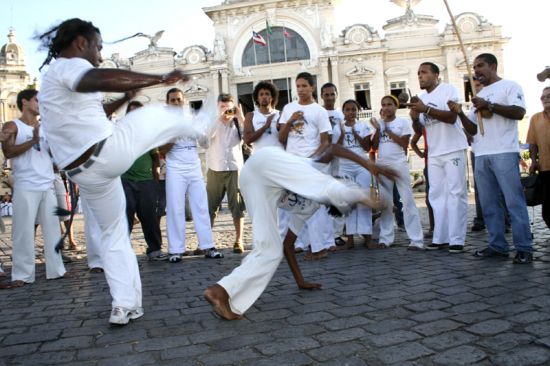Below, advertising


|
Capoeira
Notice: the article below was originally published in paper edition by the Brazilian Government; this transcript to digital media is a means to widespread this useful information.
Capoeira is one of Brazil's most important cultural
expressions.
The name "capoeira" is of indigenous origin, and means "a clearing amid the jungle", or "a clearing where there used to be a jungle"; in Brazilian northeast, many dishes are prepared with "galinha de capoeira", or "capoeira chicken", which grows in the capoeiras, as opposed to chickens raised in captive conditions.
Some careless definitions state that the "game
of capoeira" ("jogo de capoeira") is a sport practiced at academies or in
the streets, with no set rules but characteristically ordered
nevertheless, with its own music, for which the instrument
that sets the pace at practice bouts is the berimbau, or musical
bow.
This definition, however, considers capoeira only by sporting aspects, to the detriment of the ways all its
other features blend in with Brazilian society.
The purpose of these articles is to better explain those elements of capoeira
that transcend physical exercise, and cover the profound
implications of the many ways the practice of capoeira affects
the Brazilian society.

For many reasons, capoeira
may be considered one of the most complex among
Brazilian cultural expressions.
Capoeira's mythical and religious aspects, for instance,
are a part of that which is considered "sacred" in Brazil,
something that permeates all beliefs, lifestyles, dreams
and aspirations in our society.
SÚrgio Buarque de Holanda, one of the most famous Brazilian sociologists,
referredt to these aspects as religious feeling, both
intimate and close to the heart, accepting of spiritual contributions
from many sources, and a paradigm of the courteous
nature with which that writer credits the Brazilian
people.
Thus, the magic that permeates the world of capoeira
gives form to a vast
spectrum of meaning through which this expression of Afro-
Brazilian culture maintains ties with all that is sacred, and
with several of the expressions and traditions of Brazil's
popular culture.
The language of capoeira helps us understand some
of the peculiarities in the way Brazilians relate to their environment.
The names of many capoeira moves and techniques
often have to do with our natural surroundings, and
indicate how closely this practice relates to paying attention
to one's environment.
The History of Capoeira fleshes out these social aspects
by adding a wealth of relevant historical significance. The
changes through which capoeira has evolved reflect a number
of transformations occurring over the last few centuries;
a comprehensive look at the History of Brazil must therefore include
some comments about the war on capoeira, which persisted
throughout the 19th and into the early 20th century.
Despite concerted efforts at its suppression, capoeira
managed to overcome all obstacles. This is explained at least in part by the fact that capoeira is a broad-based and
deeply-rooted aspect of what it means to be Brazilian, and
therefore not something that is easily crushed.
As a product of grassroots culture, capoeira was regarded
with grave misgivings by the ruling cultural elite, as
something associated with idlers and ruffians entirely lacking
in social graces. It is therefore instructive to observe
that capoeira today serves to eliminate some of the very
social ills for which it was accusingly blamed in the past.
Capoeira has revealed itself an excellent vehicle for social
inclusion. This is largely due to the way capoeiristas, in their
circle ceremonies, place opposites on an equal footing, encourage
diversity and constantly foster the exercise of patience
and humility.
In 2007, the Ministry of External Relations of Brazil sponsored more than 50 capoeira events all over the world.
The populariztion of capoeira in other countries has greatly
strengthened and benefited this martial style. Today there
are mestres in many countries whose command of the
style is as good as in Brazil.
We can say that although capoeira has its cultural
roots in Brazil and is without question a symbol of Brazilianness
throughout the world, it is now so widely practiced on
a global scale as to constitute Brazil's contribution to the
cultural heritage of mankind.
Below, some more information which was prepared by the Brazilian Government to widespread knowledge and practice of capoeira around the World:
»War on Capoeira. Why and how Brazilians attempted to kill capoeira.
Back to Top
|
|

